Brazil
From-The-Road Scribbles Of Travel Through Parts Of Latin America’s Largest Country
Igauzu Falls, Brazil. September 12, 2015
Brazil (September 10-18 & December 8-14 2015)

Officially the Federative Republic of Brazil, this is the largest country in Latin America & the largest Portuguese speaking country on Earth. The world’s fifth largest country, Brazil has a coastline stretching for 7,000 kilometres, plenty of room for all those wondrous beaches on which to showcase all those wondrous beach bodies and football skills. From the enormity & remoteness of the Amazon Basin in the north to the hedonism of the flamboyant city carnivals, seeing all there is too see in Brazil would take a lifetime. Maybe two. My travels in Brazil were limited to the lower portion of the mostly tropical country as part of my wider South American adventure during the second half of 2015. I didn’t see as much of Brazil as I wanted or had planned to see at the outset but this is where I went & what I saw when there.
Read all postings from the road in chronological order or jump to specific postings using these links.
Foz do Iguaçu/Iguazu Falls || Itaipu Dam || Ilha de Santa Catarina || Porto Alegre || Rio de Janeiro
Archived Postings From The Brazilian Road (In Chronological Order)
FOZ DO IGUACU & IGUAZU FALLS
Date || September 12, 2015
Location || Foz do Iguaçu, Brazil ( )
)
Having crossed over the relatively short distance from Paraguay, my first stop in Brazil, Latin America’s biggest country, was Foz do Iguaçu, the largest of three frontier towns within a stone’s throw of each other – the Argentine town of Puerto Iguazú and the Paraguayan city of Ciudad del Este are all within spitting distance – & the one I chose to use as a base for visiting nearby Iguazu Falls. Situated on the border of Brazil & Argentina, the falls, surrounded by lush tropical forest, are easily one of the world’s greatest natural wonders and the probably, after Christ the Redeemer in Rio, Brazil’s biggest draw.
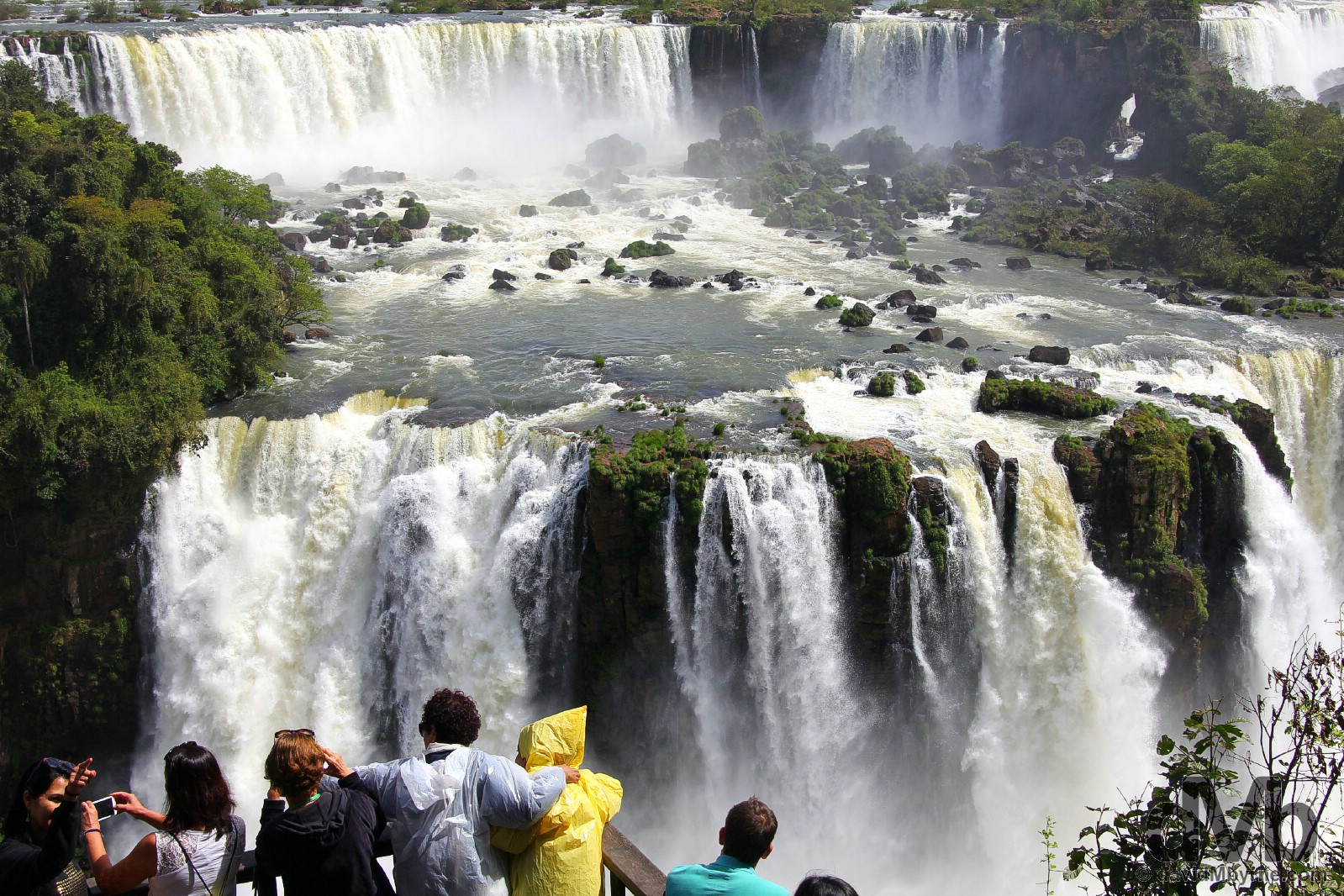
Iguazu Falls in Parque Nacional Do Iguacu, Brazil. September 12, 2015.
Iguazu Falls || A New7Wonder
Chosen as one of the New7Wonders of Nature in 2011, Iguazu Falls, meaning rather aptly ‘Big Water’ in local Guaraní, are the spectacular, wow-inducing centerpiece of the bi-national (shared with Argentina) UNESCO-listed Iguacu National Park. ‘Discovered’ in 1542 by Spaniard Alvar Nunez Cabeza, the falls, comprising 275 individual thunderous walls of water, are formed by the Rio Iguaçu tumbling over a 3 kilometre-wide span of 80 metre-high cliffs. Needless to say the spectacle of the falls, billed as a natural miracle, is quite impressive.
– UNESCO commenting on Iguaçu National Park
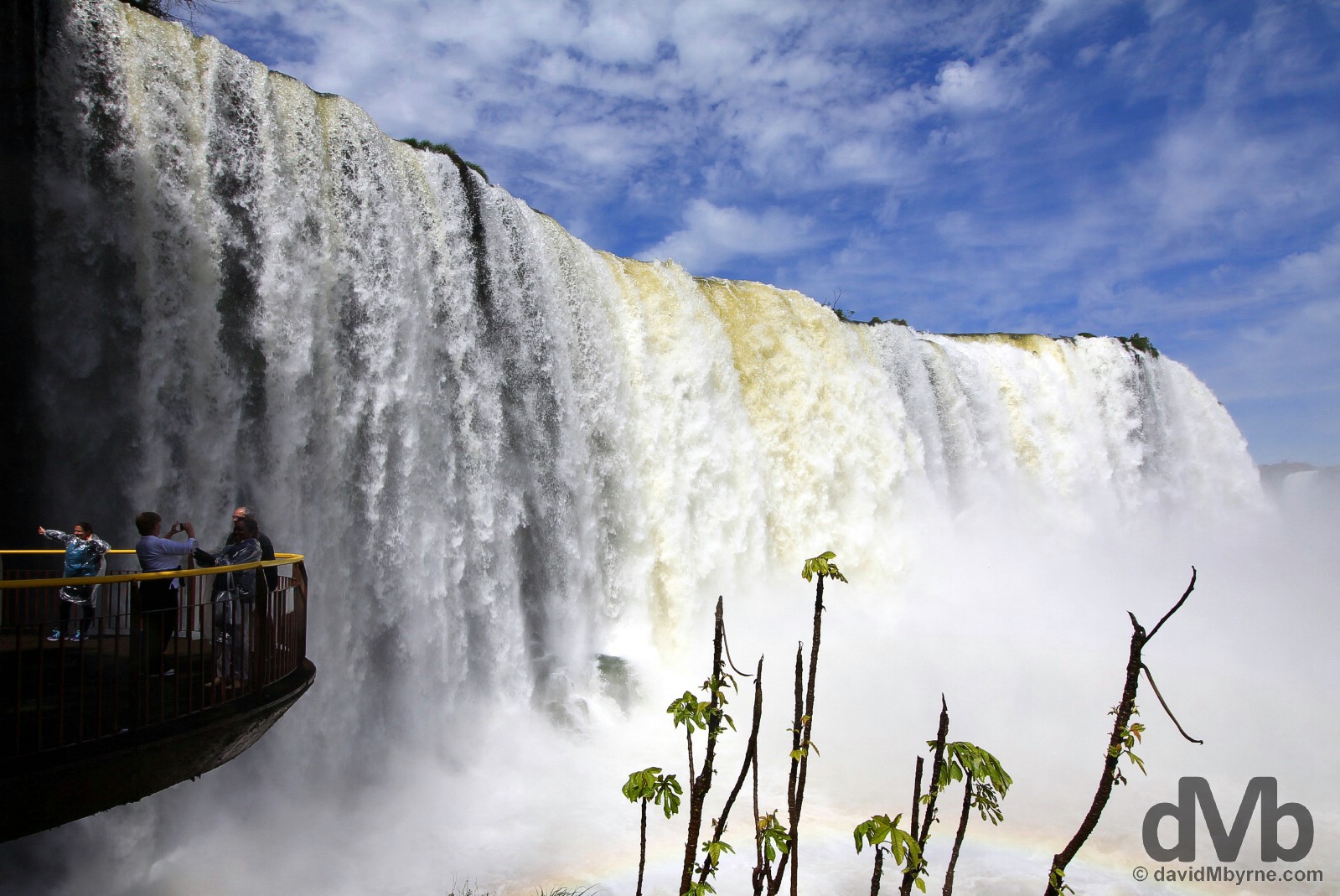
Iguazu Falls in Parque Nacional do Iguaçu, Brazil. September 12, 2015.
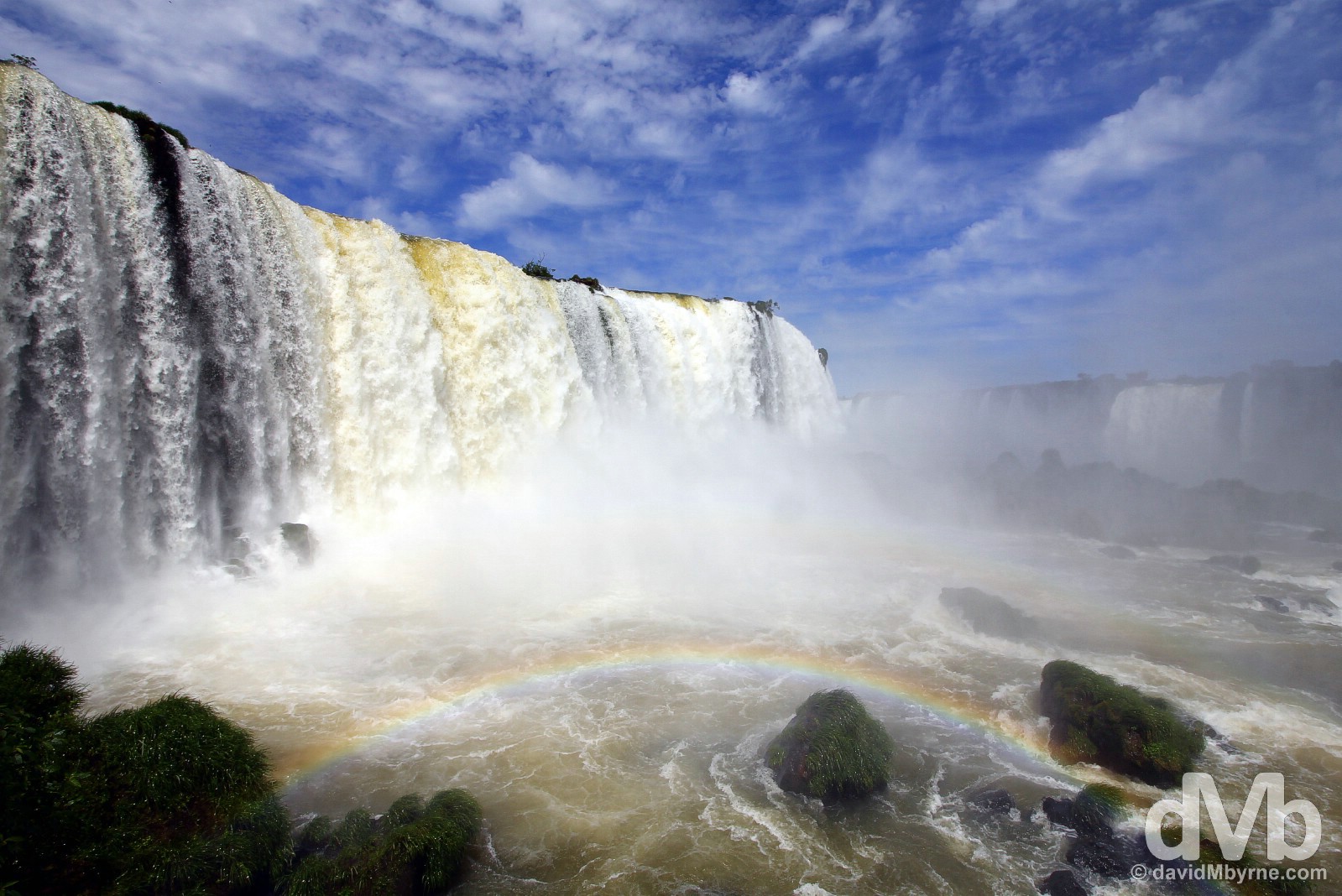
Rainbow at Iguazu Falls in Parque Nacional do Iguaçu, Brazil. September 12, 2015
Iguazu Falls || Brazil Vs. Argentina
The best overall albeit somewhat distant view of the falls, via a 1.5 kilometre cliffside trail with many viewpoints, is on the much smaller Brazilian side. The Argentine side, which lays claim to the majority of the falls, offers more extensive hiking/walking trails & closer access to the individual walls of water. Some say the only true way to experience the falls is via the river itself. Options for doing so, and getting royally soaked in the process, are all from jetties on the Argentinian side, clearly visible from the relative dryness of the Brazilian side.
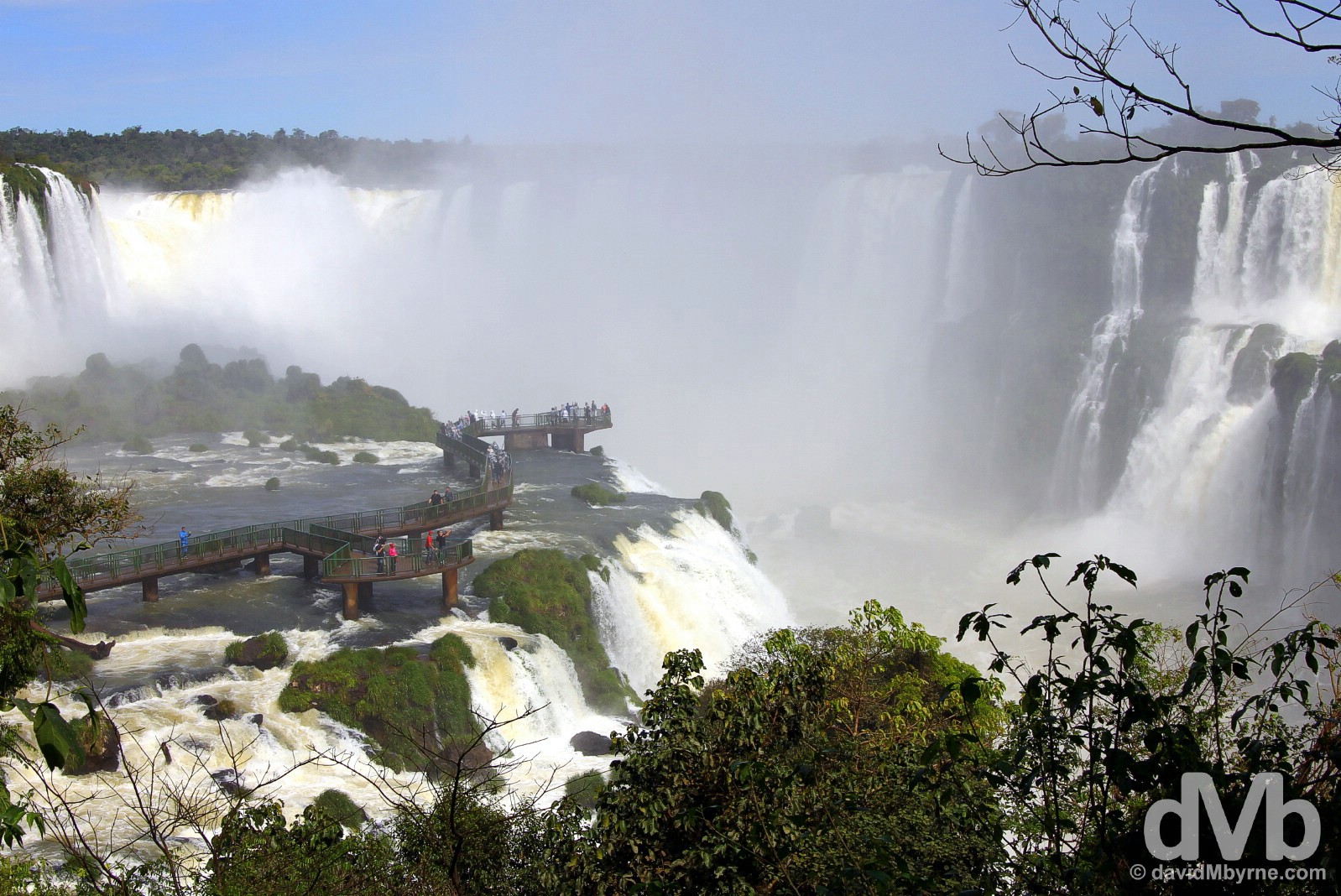
It’s not all dry on the Brazilian side. Seen here is the main Brazilian platform snaking out into the falls (that’s Argentina in the distance). This is as close as you’re going to get from the Brazilian side to the ominously named Garganta do Diabo (Devil’s Throat), probably the world’s biggest open-air shower & the most majestic of all the individual Iguaçu cascades regardless of the side – a soaking is guaranteed with a ready supply of overpriced ponchos never too far away. Iguazu Falls in Parque Nacional do Iguaçu, Brazil. September 12, 2015.
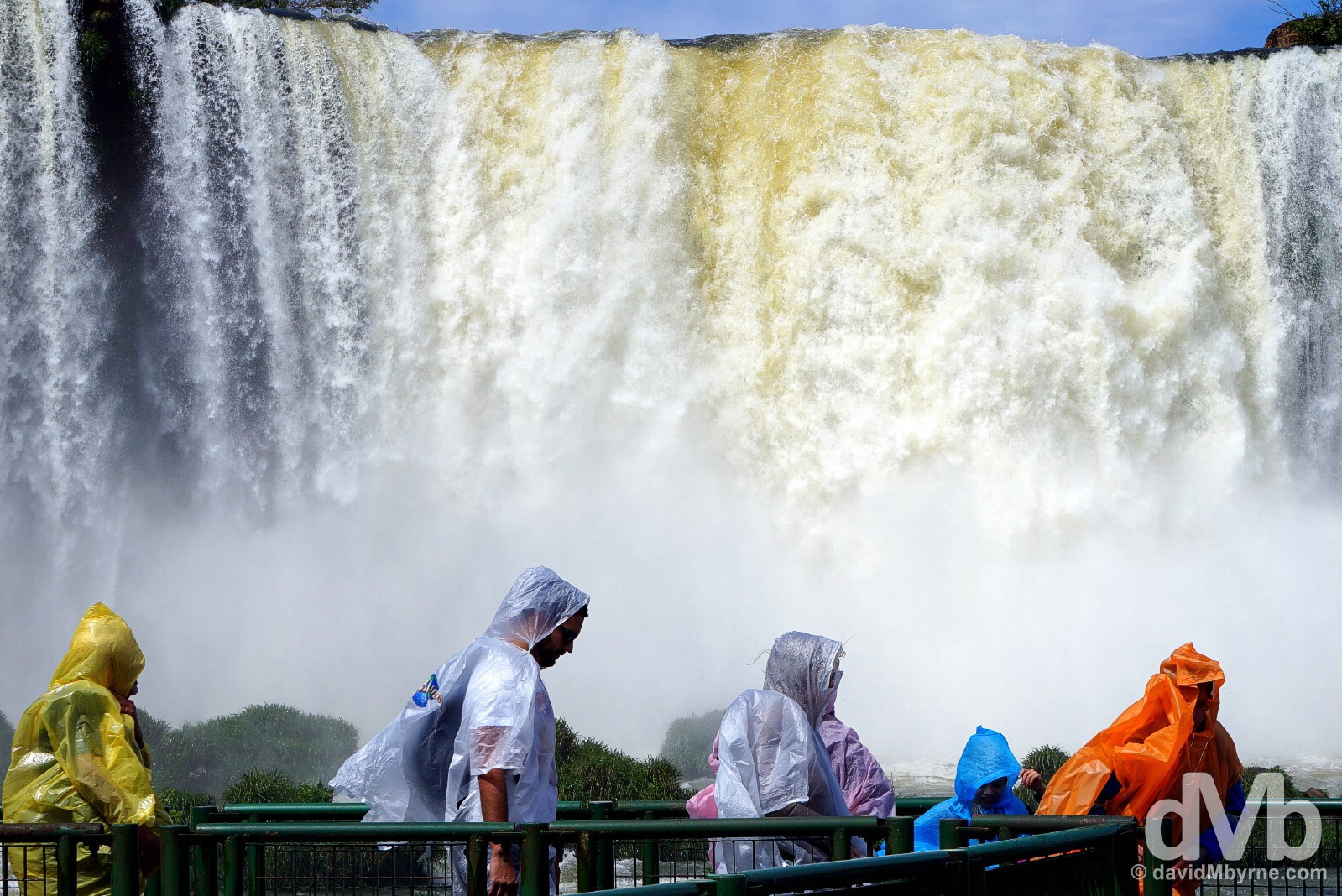
Some of the poncho horde on the Garganta do Diabo (Devil’s Throat) viewing platform. I had a hell of a job keeping my lens front element dry out here. I largely succeeded, to the detriment of efforts to keep myself dry. Iguazu Falls, Parque Nacional do Iguaçu, Brazil. September 12, 2015.
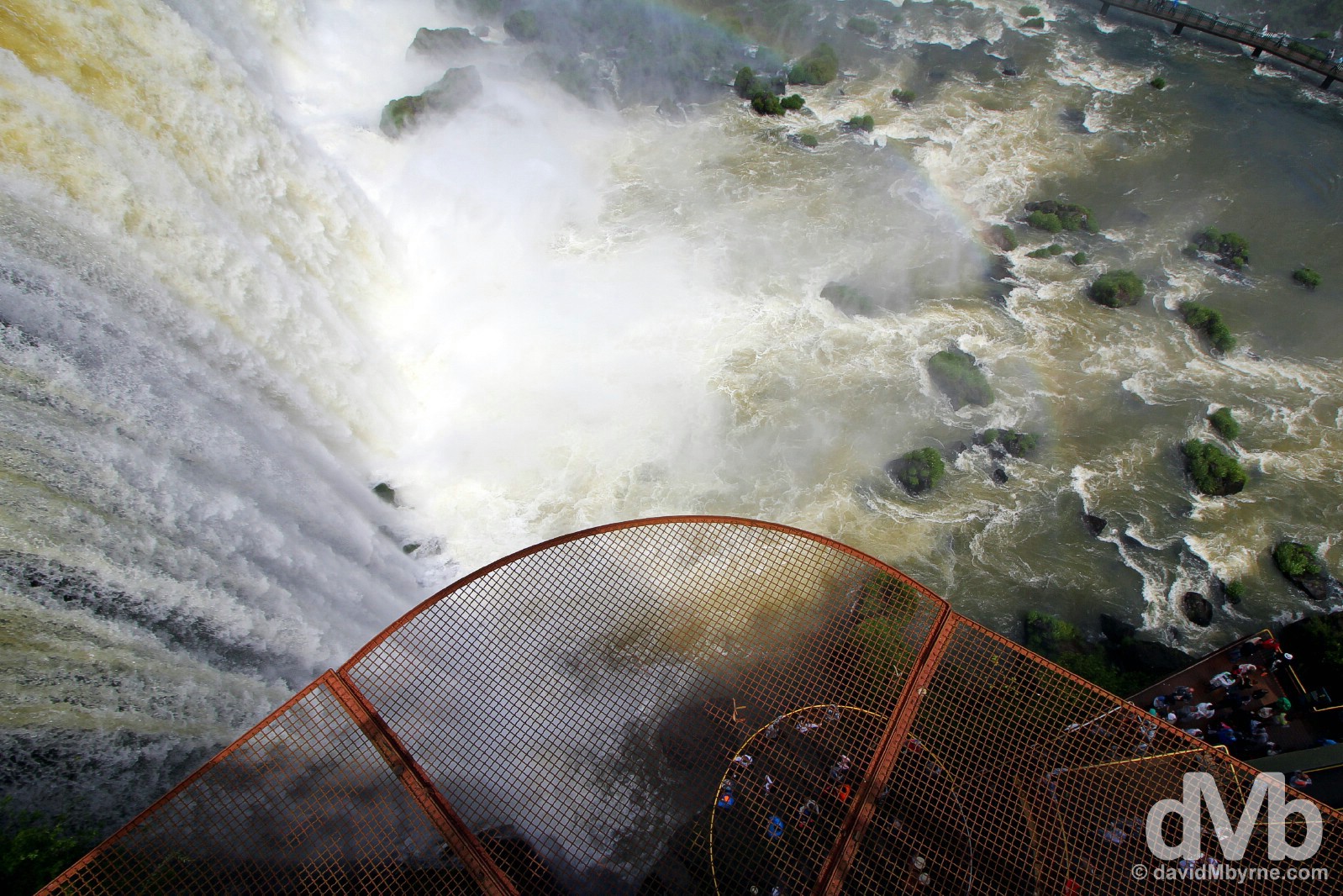
Elevator views from the main cliffside viewing platform on the Brazilian side of the Iguazu Falls, Parque Nacional do Iguaçu, Brazil. September 12, 2015.

Couple selfie at Iguazu Falls in Parque Nacional do Iguaçu, Brazil. September 12, 2015.
– Eleanor Roosevelt upon seeing Iguazu Falls
ITAIPU DAM
Date || September 13, 2015
Location || Foz do Iguaçu, Brazil ( )
)
With so much water in these parts there was bound to be a dam hiding around here somewhere. Twelve kilometres north of Foz do Iguaçu is the Itaipu Dam, a gargantuan wall of concrete straddling the Brazil-Paraguay border that brings a tear to even the widest of wide-angle lenses.
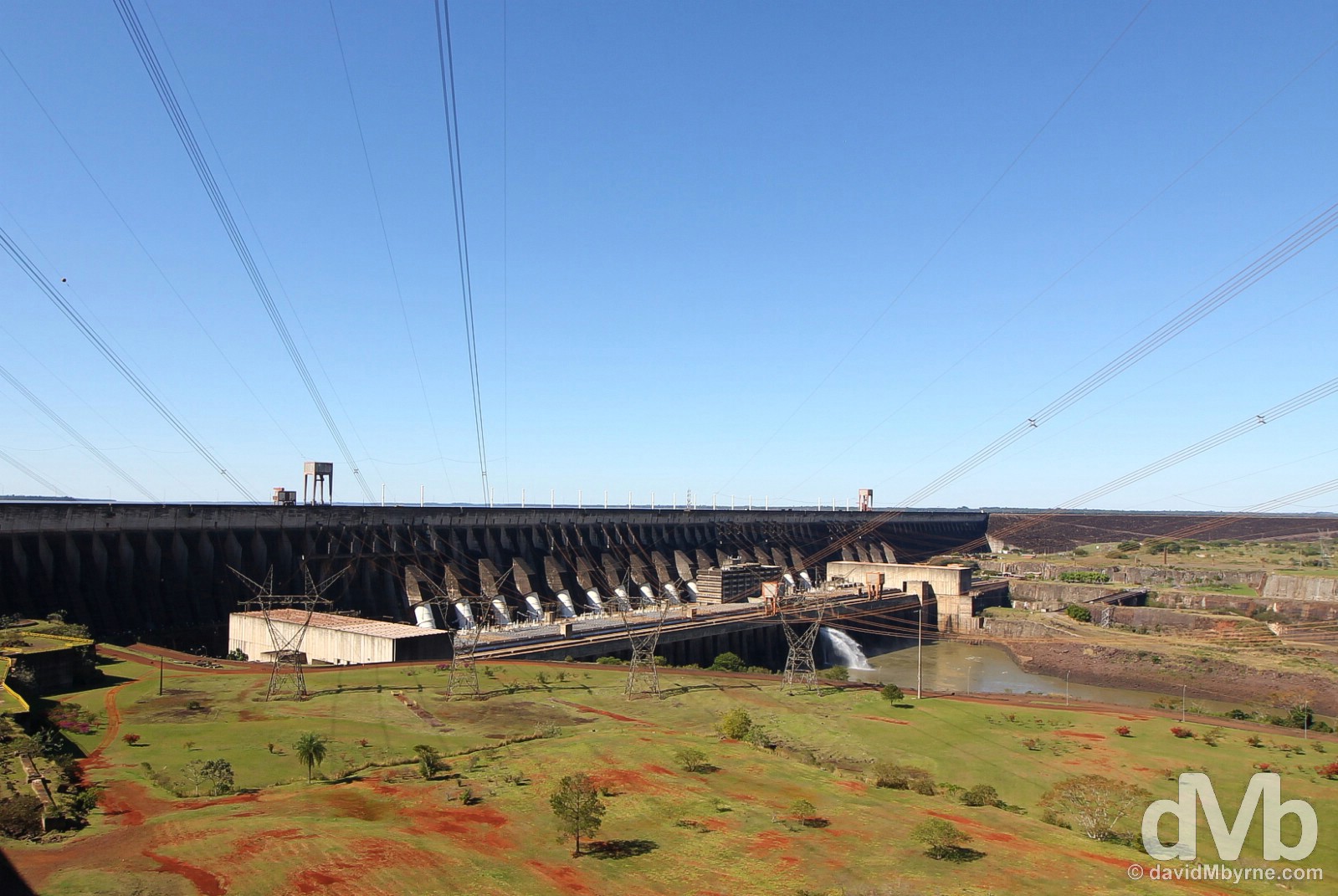
An overview of the massive Itaipu Dam on the Brazilian Paraguayan border. September 13, 2015.
Itaipu Dam
Construction started in 1974 and it took a total of 40,000 workers a decade to build what is today one of the Seven Wonders of the Modern World as chosen by the American Society of Civil Engineers. The dam started generating electricity in 1984, reached 90% capacity (18 turbines) in 1991 & only hit full capacity in 2007 – its full 20 turbine/14,000 MW output is second only to the 22,400 MW of China’s Three Gorges Dam which I visited way back in 2004 when it was nearing completion. Costing a whopping US$25 billion & using about 15 times more concrete than was needed to construct the Channel Tunnel, the gargantuan dam straddles the Brazilian-Paraguayan border. The structure itself is an impressive wall of concrete almost eight kilometres long & nearly 200 metres high (196 metres to be precise). The whole thing is ten times as heavy and eighteen times the size of Hoover Dam with a spillway able to accommodate a flow of water 40 times greater than that of the Iguaçu Falls. A feel-good initiative between the two South American neighbous, the dam supplies between 80 & 90% of Paraguay’s & some 19% of Brazil’s electric needs.
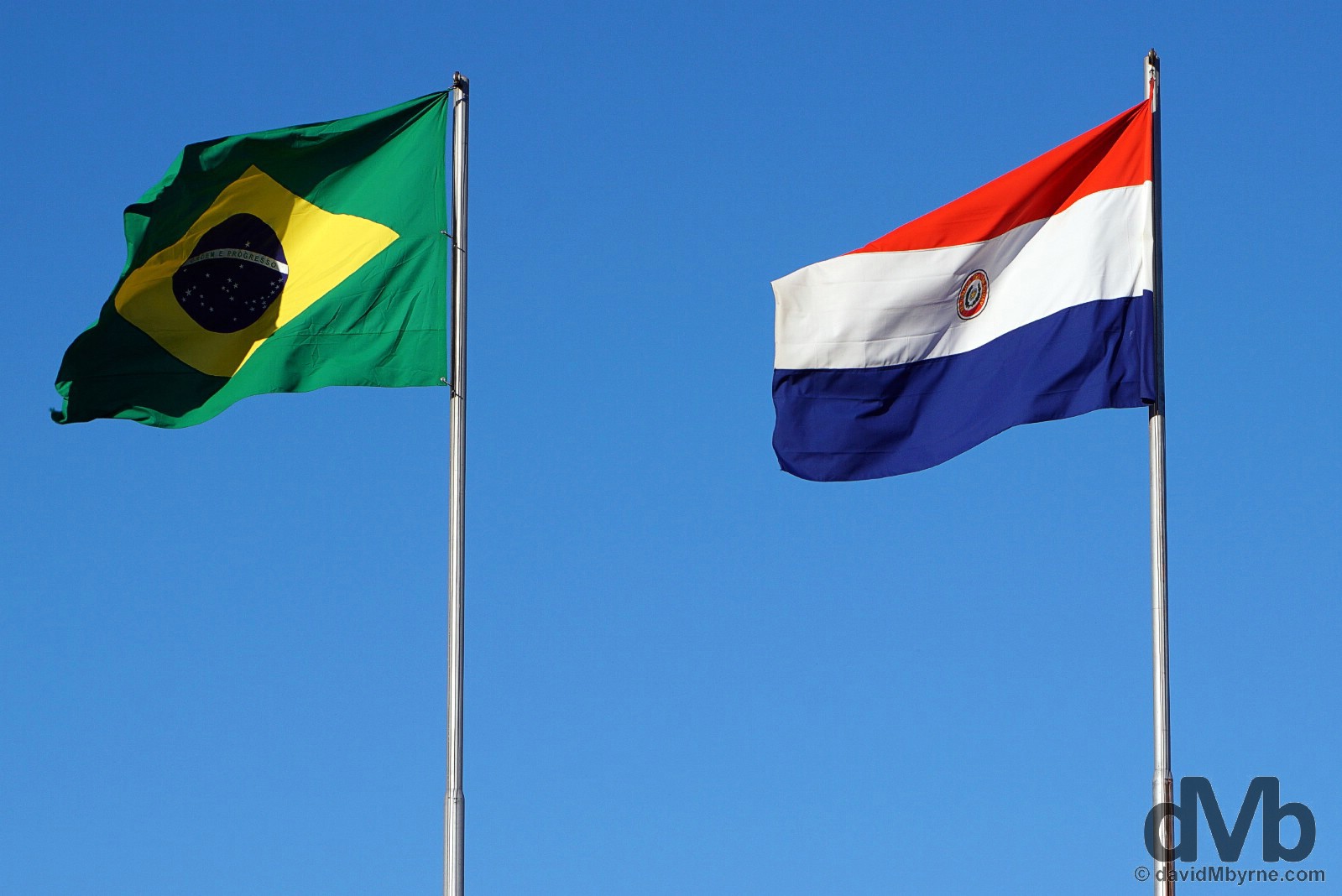
Brazilian & Paraguayan flags at the Visitor’s Centre of the Itaipu Dam on the Brazil-Paraguay border. September 13, 2015.
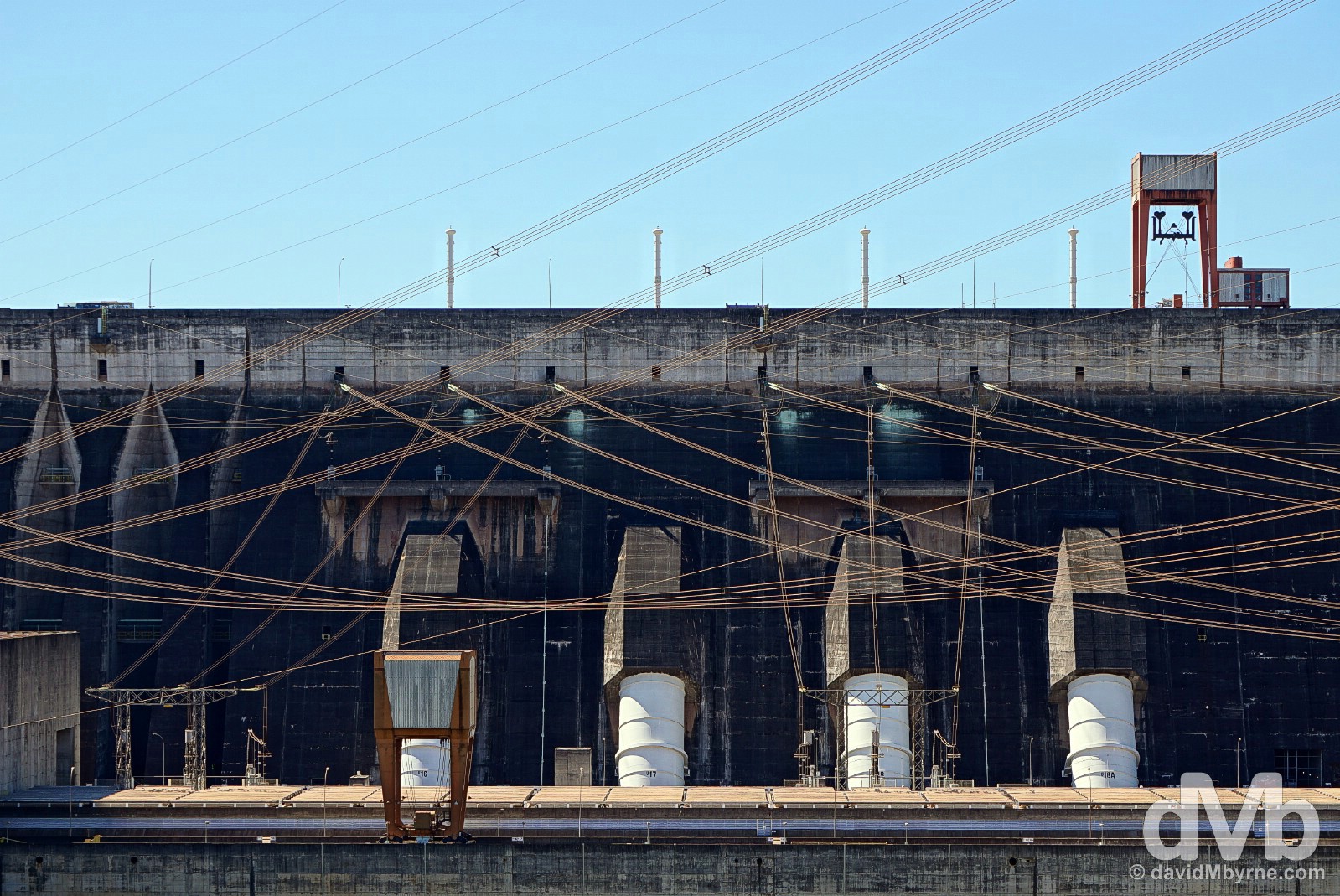
A section of the 196 metre-high wall of the Itaipu Dam showing 4 of the dams 20 turbines. A tourist bus is (barely) seen here – at the top of the dam to the extreme left of the image – in an rather poor attempt to give some semblance of scale. Hey, I tried. Itaipu Dam on the Brazilian Paraguayan border. September 13, 2015.
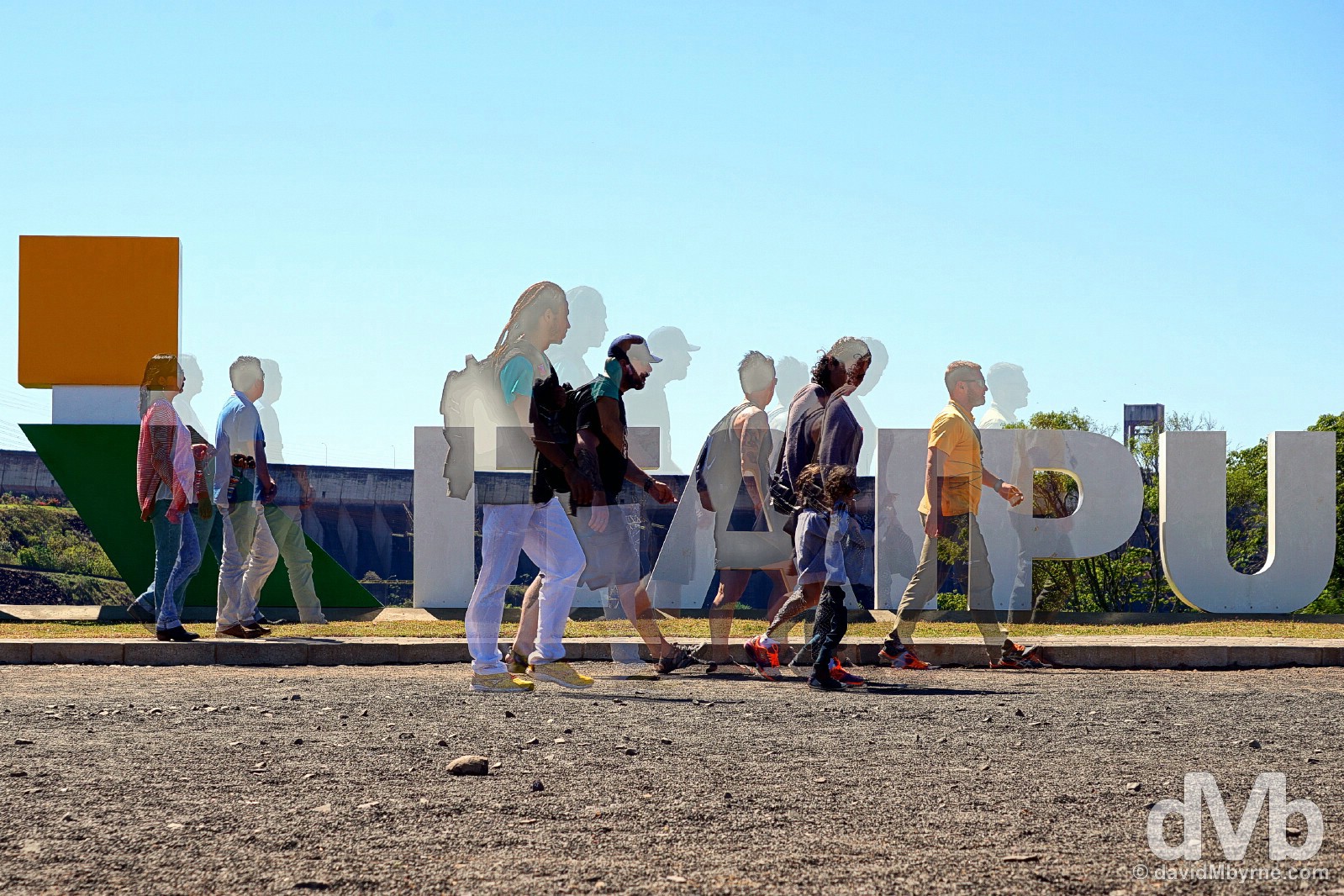
Tours of the Itaipu facility are offered on both sides of the Brazil-Paraguay border. The Brazilians charge for their tour, the Paraguayans don’t – I only assume it’s part of a strategy to attract people to Paraguay, one of the least visited countries in South America. While the tour I took from the Brazilian side was quick with facts & figures about the dam’s obvious human accomplishments & its economic benefit to the region, there, & while I’m no tree hugger, was no mention of the severe environmental consequences of the project – the 1350 km², 220 metre-deep reservoir created by the dam drowned Sete Quedas, a set of waterfalls that was more impressive than the nearby Iguazú Falls themselves. At the Itaipu Dam on the Brazilian Paraguayan border. September 13, 2015.
ILHA DE SANTA CATARINA
Date || September 17, 2015
Location || Lagao da Conceicao, Ilha de Santa Catarina, Brazil ( )
)
I’m a couple of months early here sampling the seasonal delights of Ilha de Santa Catarina, a small subtropical island on Brazil’s Southern Atlantic coast, one renowned throughout the country for its beaches, tranquil fishing villages & general laid-back Mediterranean vibe, all despite its built-up, developed status.

Havaianas for sale in Centrinho da Lagoa on Ilha de Santa Catarina. Brazil wouldn’t be the cheapest country in South America – one of the most expensive actually – but, & even here on a resort island, you can still pick up a pair of the quintessential Brazilian flip-flops for as little as 14 Brazilian Reals (€3). Centrinho da Lagoa, Ilha de Santa Catarina, Brazil. September 16, 2015.
It’s only mid-September; it was yesterday when I arrive and it still is today. The sun comes out, things hot up, & the beaches, roads, accommodation, restaurants, cafes & bars really fill to capacity come November, the onset of summer down here south of the equator. But right about now this Brazilian resort island is rather sleepy. Chilly & a tad damp too, despite the high 20 degree Celsius temperatures I’ve experienced over the last few days. If I were a beach person I probably wouldn’t have bothered coming here at all this time of year. I’m not – a beach person – so I did decide to swing by en route down the Brazilian Atlantic coast to Uruguay, mainly because it was a convenient break in the journey from Foz do Iguacu further north & because I hadn’t seen the sea in almost 2 months – I’m not particularly fond of the sea but having grown up beside it means I like to lay eyes on it every now and then, if not get into it.
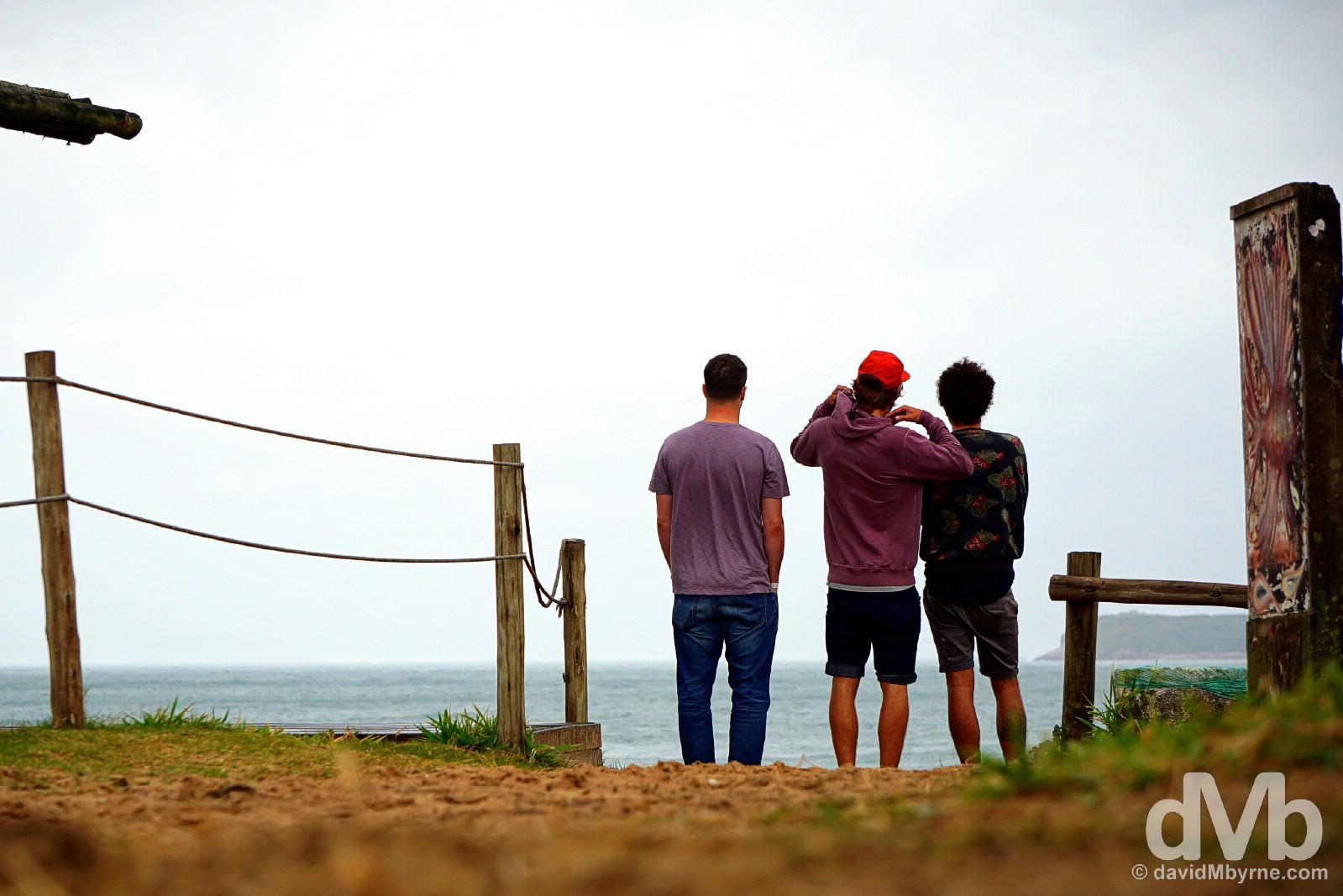
Overlooking the Atlantic Ocean & a damp Praia Mole on Ilha de Santa Catarina, Brazil. September 17, 2015.
Centrinho da Lagoa
Ilha de Santa Catarina’s Centrinho da Lagoa is the island’s ground zero, a bustling little town on the shores of the island’s Lagoa da Conceicao, it’s central lagoon and most predominant feature.
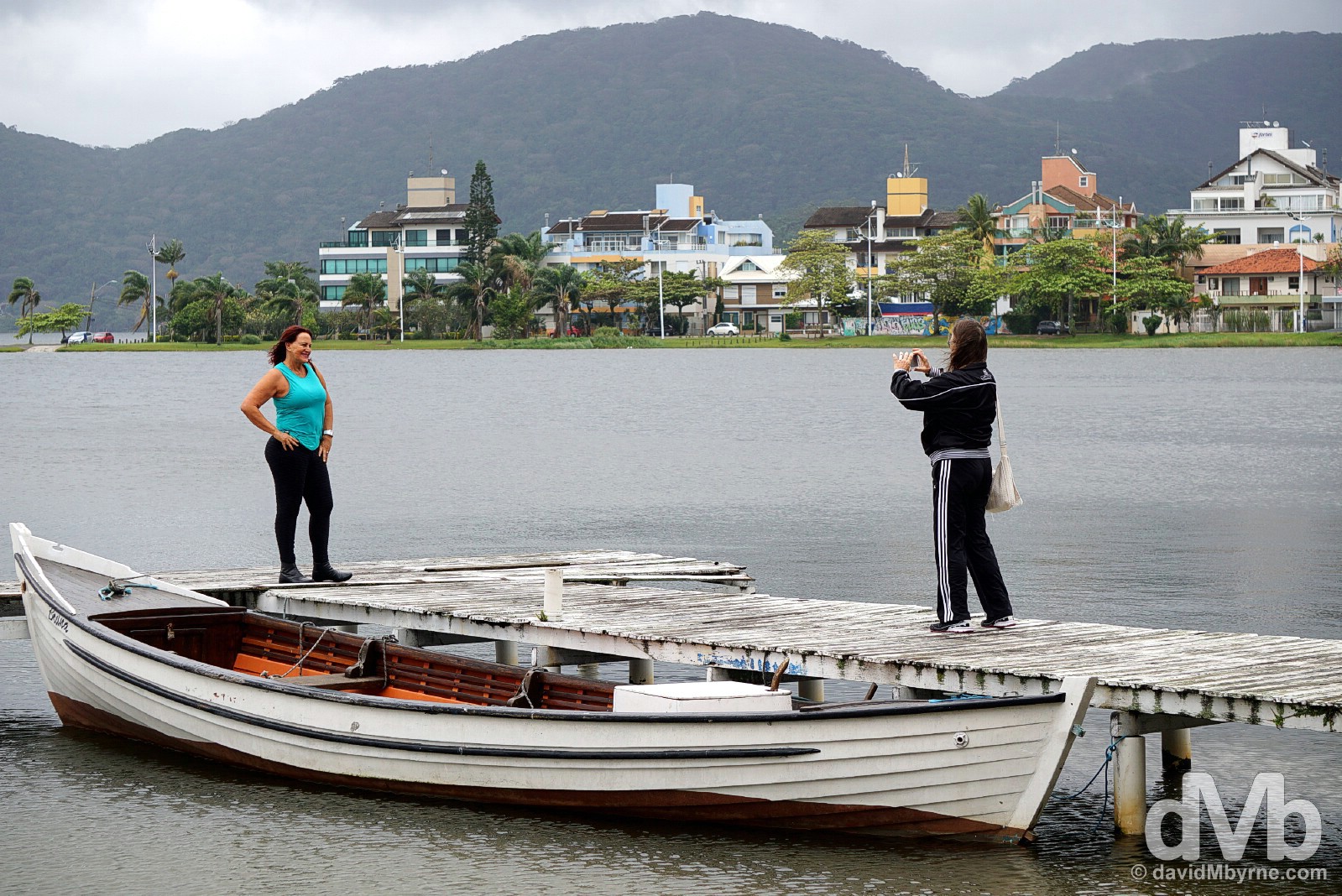
There are still tourists here this time of year. Just not too many. Lakeside in Centrinho da Lagoa on Ilha de Santa Catarina, Brazil. September 17, 2015.
Full of places to stay, shops, bars, restaurants & cafes, Centrinho da Lagoa makes a convenient base for exploring the rest of the 54 kilometre long by 18 kilometre wide island. From my base Centrinho da Lagoa I walked & bused it to various parts of the island, all in a bid to sample the island’s advertised charms, namely its remote fishing villages & beaches.
Costa da Lagoa || Fishing Village #1
Costa da Lagoa is a small fishing village that’s accessible only via boat or a 6 kilometre (one-way, 12 kilometre round trip) walk along the shores of Lagoa da Conceicao from Centrinho da Lagoa.
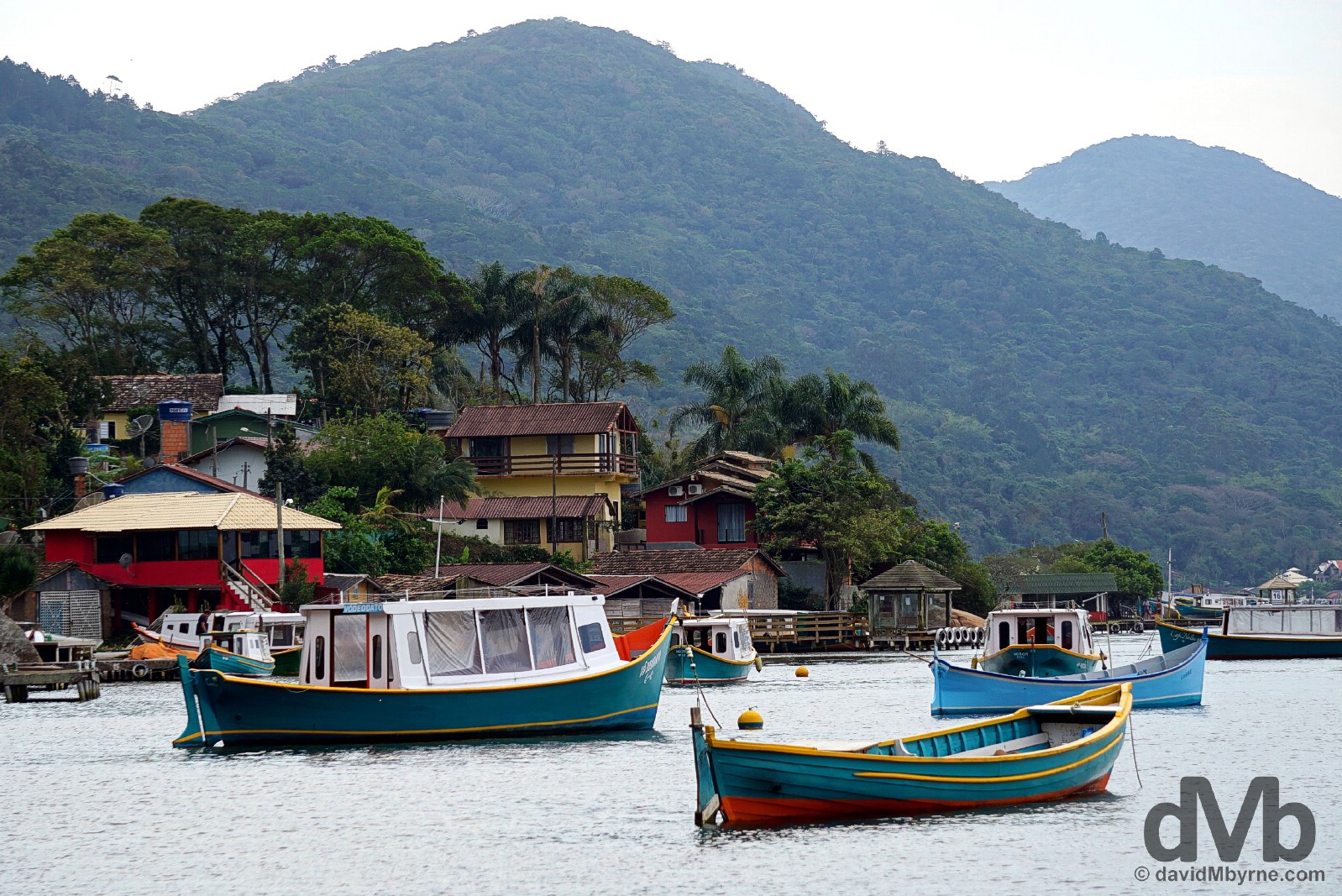
Boats & the village of Costa da Lagoa on the shores of Lagoa da Conceica, Ilha de Santa Catarina, Brazil. September 16, 2015.
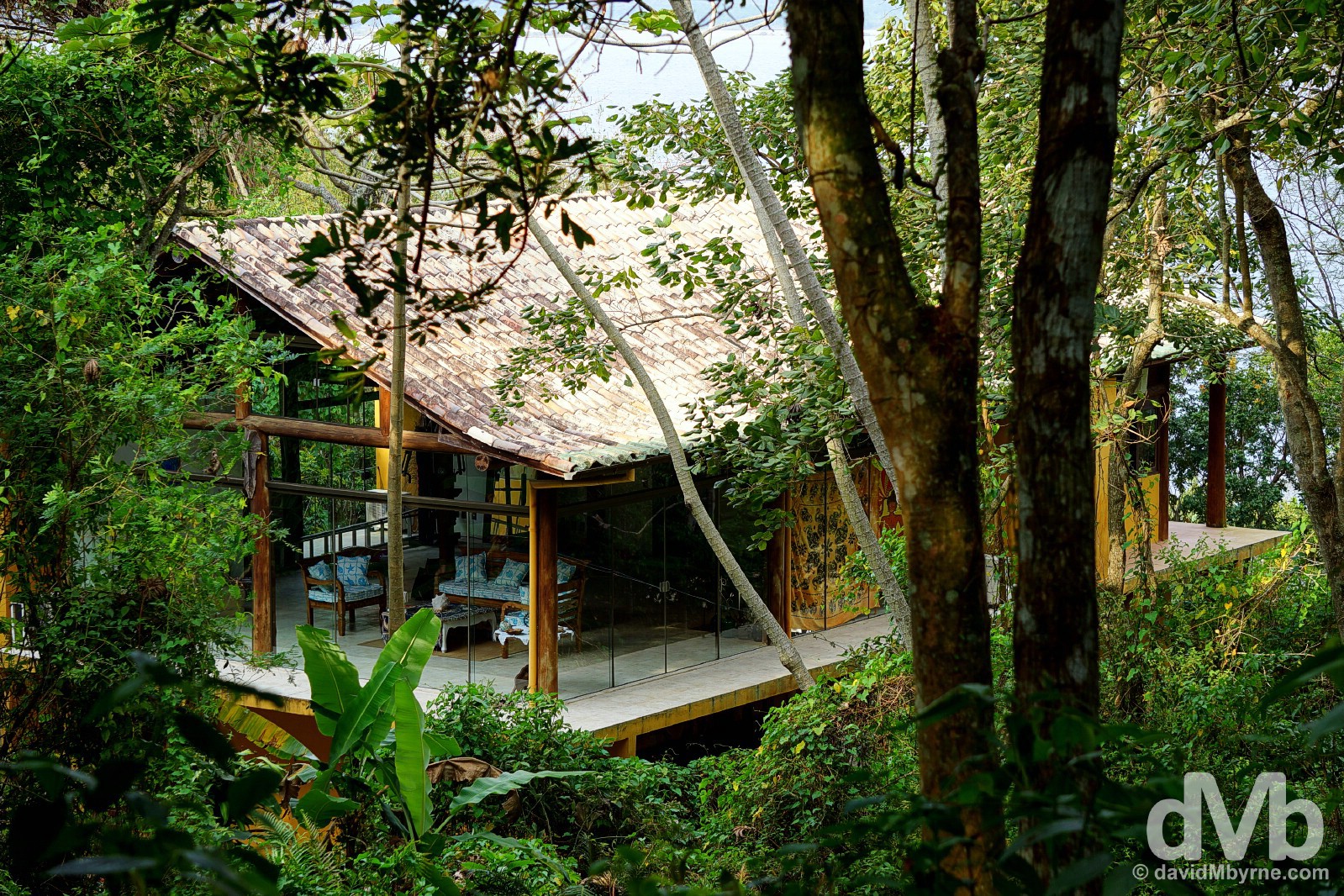
Always up for a good amble, I walked the 6 kilometres from Centrinho da Lagoa to Costa da Lagoa along the forested lakeside track joining the two settlements (I opted for the boat back). I passed many an impressive abode en route, all nicely secluded and with impressive lake views. This holiday/resort island is one of the wealthiest places in Brazil and around here it shows. Ilha de Santa Catarina, Brazil. September 16, 2015.
Barra da Lagoa || Fishing Village #2
A short bus ride from Centrinho da Lagoa is the sleepy village of Barra da Lagoa, somewhere that feels far removed from the tourism frenzy griping other areas of the island.
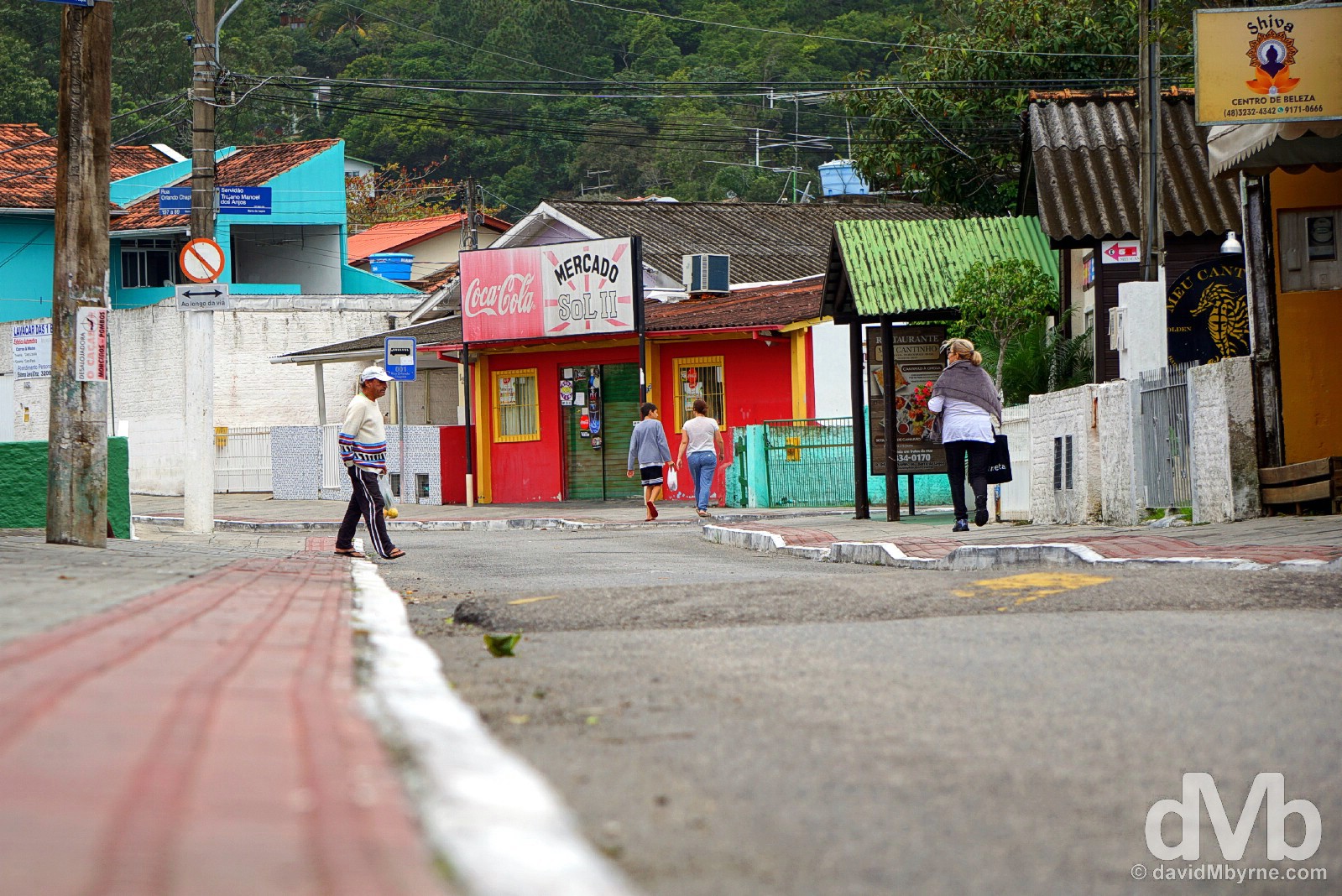
Fishing still rules the roost here in Barra da Lagoa, a colourful, rustic & sleepy place where not a lot seems to stir. Ilha de Santa Catarina, Brazil. September 17, 2015.
Praia Mole || Beach
Billed as one of Brazil’s best beaches, Praia Mole (Mole Beach), located on the island’s east shore south of Barra da Lagoa, is a classic seasonal beach – popular with swimmers in the summer and surfers in the winter. Needless to say this time of year there are very few of the former and a healthy sampling of the latter.
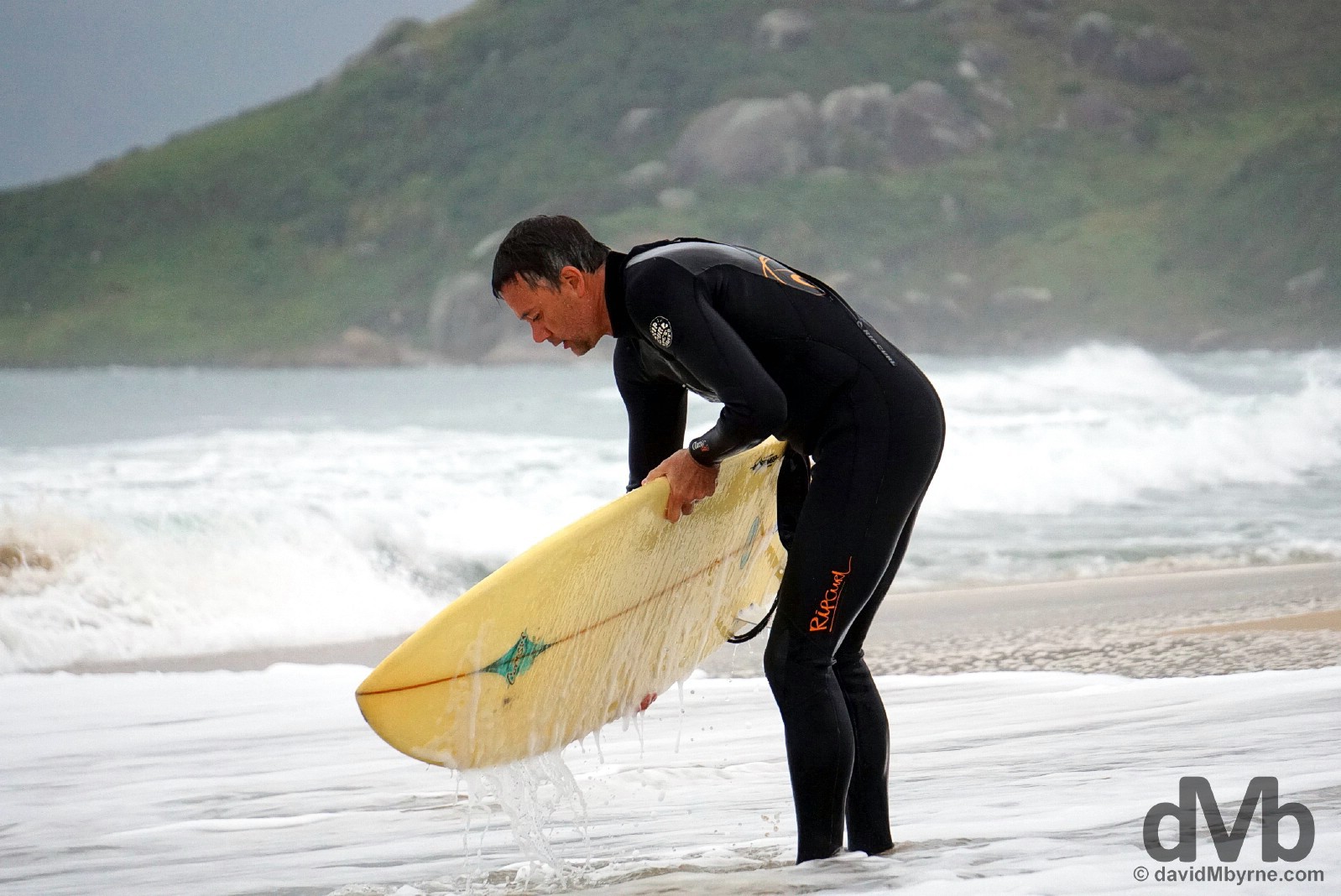
A surfer on Praia Mole on Ilha de Santa Catarina, Brazil. September 17, 2015.
Coast to Coast || Atlantic to Pacific
It had been a while so I can only assume I was excited to see it. I got a bit too close to the Atlantic water this morning when photographing the surfers braving the Praia Mole waves. From here, and beginning today, I start a 10-day, 3,000 kilometre overland east-to-west dash across the continent, via Uruguay, in a bid to get to Santiago, Chile (where they’ve just experienced an earthquake), by September 27, in time for my flight to Easter Island. Best get moving so. That’s it from Brazil for now but I’ll be back in a couple of month. Hopefully it’ll have warmed up a bit by then.
PORTO ALEGRE
Date || December 8th, 2015
Location || Porto Alegre, Rio Grande do Sul, Brazil ( )
)
The oppressive temperatures mean it still may not feel like Christmas is around the corner but in parts it certainly looks like it.

I first saw Christmas decorations in a Chilean supermarket back in early October but my peregrine existence means I’ve largely avoided the unnecessarily long buildup to a time of the year that, rampant over commercialism aside, I still love. I can never before recall sweating while photographing a Christmas tree but the perspiration was flowing when photographing the massive plastic tree yesterday in Alfandega Square in central Porto Alegre. It was also the first time this season that I heard a Christmas song, any Christmas song – hearing Bing Crosby’s White Christmas in 30+ degree Celsius temperatures was as alien to me as the sight of seeing such a massive ornamentation in such temperatures. Christmas in Alfandega Square, Porto Alegre, Rio Grande do Sul, Brazil. December 8, 2015.
I still have difficulty believing that I was freezing my you-know-what’s off while smiling at penguins in Antarctica mere days ago. Here in tropical Brazil the White Continent feels a long, long ways away, maybe because it is. I’ve really been moving of late. A flight from the Ushuaia at the End of the World to Buenos Aires, where I spent a day, followed by a combination of ferry & bus journeys from Argentina & through Uruguay has me here in tropical southern Brazil, somewhere I last was back in early September when it was nowhere near this warm. I’m one bus ride shy of Rio de Janeiro, the penultimate stop on my mammoth 2015 itinerary. I’ll spend the next 24 hours on a bus getting there, an iconic world destination I’ve longed to visit for as long as I’ve longed to travel. And I’ve even put some Christmas music on my iPod to help pass the journey. Oh yes, it was late coming but I’m in the Christmas mood now alright.
For more pictures & insights from my time in the city, check out my dedicated Porto Alegre posting.
RIO DE JANEIRO
Date || December 12, 2015
Location || Rio de Janeiro, Brazil ( )
)
It has been a manic last few days here in Rio de Janeiro, an iconic worldwide destination I’ve wanted to visit for as long as I’ve travelled. I’ve kept busy. I’ve scooted here and there, pointing my camera at this & that. Conclusion – iconic Rio is much better viewed from on high.
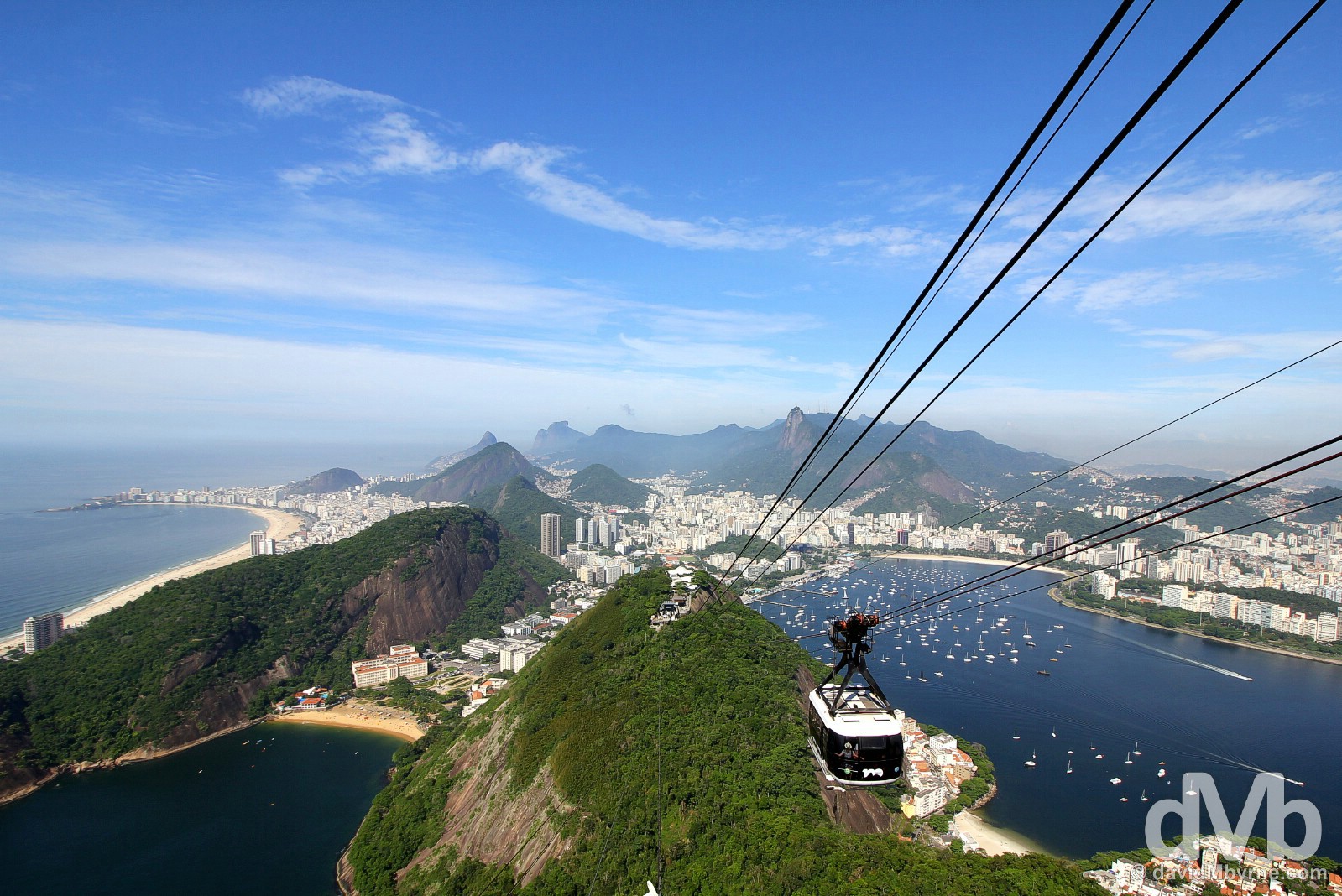
Rio de Janeiro as seen from atop Sugarloaf Mountain. Rio de Janeiro, Brazil. December 12, 2015.
There’s no doubt Rio is alluring, boasting as it does one of the most enviable settings of any world metropolis, easily its biggest plus. World-renowned place names like Copacabana and Ipanema & a few iconic landmarks, both natural (Sugarloaf Mountain) & man-made (Christ the Redeemer, the Maracana), add to the aura. Beautiful weather & an equally beautiful people with a lust & verve for life, one that reaches its zenith during Carnival, combine for quite the package. Yes Rio is cool. Rio is beautiful.
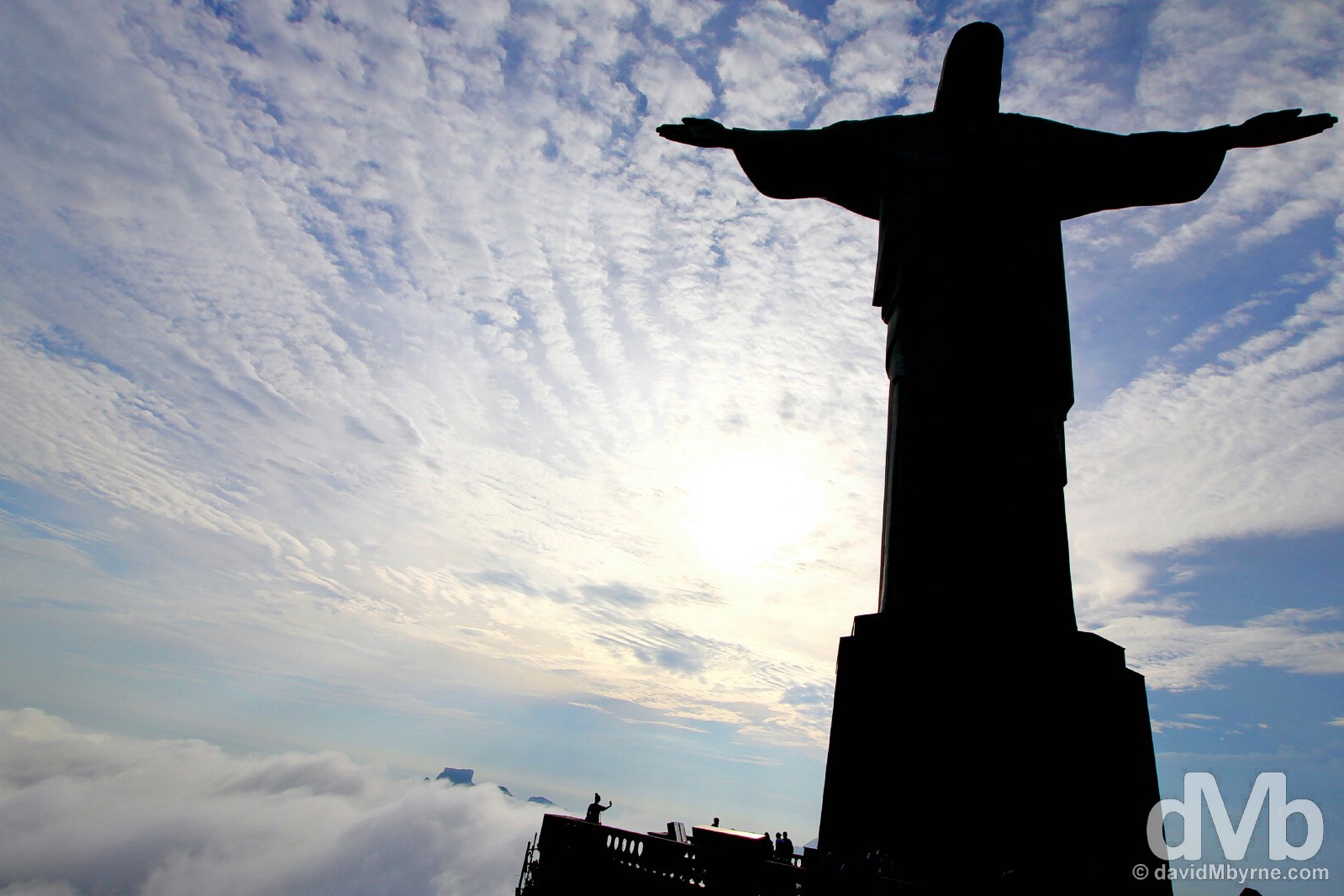
Christ the Redeemer atop Corcovado mountain in Tijuca Forest National Park, Rio de Janeiro, Brazil. December 12, 2015.
Cool & beautiful Rio may be but it’s not the utopia it seems from elevated vantage points. Now is not the time or place to elaborate on the obvious Rio negatives – the dishevelled look to the place, the heat, the noise, the repugnant smell of feces & urine, the homelessness, the need to be alert, be on your guard at all times. Nope, now is not the time. Now is the time to get ready to leave the city. I’ll do so in the morning when I’ll retrace my steps of a few days ago as I head back to Sao Paulo, the biggest & probably the most daunting city on the whole South American continent. I only passed through a few days ago en route to Rio but I’ll spend the night there tomorrow ahead of my flight home the day after. Yep, the end of this epic year of travel is nigh. Which is fine. I’m about ready for home at this stage. More to come from Rio, eventually.
For more pictures & insights from my time in the city, check out my dedicated Rio de Janeiro posting.
